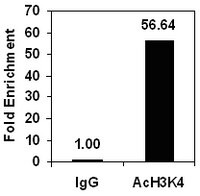Myeloblastic cell lines mimic some but not all aspects of human cytomegalovirus experimental latency defined in primary CD34+ cell populations.
Albright, ER; Kalejta, RF
Journal of virology
87
9802-12
2013
Show Abstract
Human cytomegalovirus (HCMV) is a significant human pathogen that achieves lifelong persistence by establishing latent infections in undifferentiated cells of the myeloid lineage, such as CD34(+) hematopoietic progenitor cells. When latency is established, viral lytic gene expression is silenced in part by a cellular intrinsic defense consisting of Daxx and histone deacetylases (HDACs) because pp71, the tegument transactivator that travels to the nucleus and inactivates this defense at the start of a lytic infection in differentiated cells, remains in the cytoplasm. Because the current in vitro and ex vivo latency models have physiological and practical limitations, we evaluated two CD34(+) myeloblastic cell lines, KG-1 and Kasumi-3, for their ability to establish, maintain, and reactivate HCMV experimental latent infections. Tegument protein pp71 was cytoplasmic, and immediate-early (IE) genes were silenced as in primary CD34(+) cells. However, in contrast to what occurs in primary CD34(+) cells ex vivo or in NT2 and THP-1 in vitro model systems, viral IE gene expression from the laboratory-adapted AD169 genome was not induced in the presence of HDAC inhibitors in either KG-1 or Kasumi-3 cells. Furthermore, while the clinical strain FIX was able to reactivate from Kasumi-3 cells, AD169 was not, and neither strain reactivated from KG-1 cells. Thus, KG-1 and Kasumi-3 experimental latent infections differ in important parameters from those in primary CD34(+) cell populations. Aspects of latency illuminated through the use of these myeloblastoid cell lines should not be considered independently but integrated with results obtained in primary cell systems when paradigms for HCMV latency are proposed. | 23824798
 |













